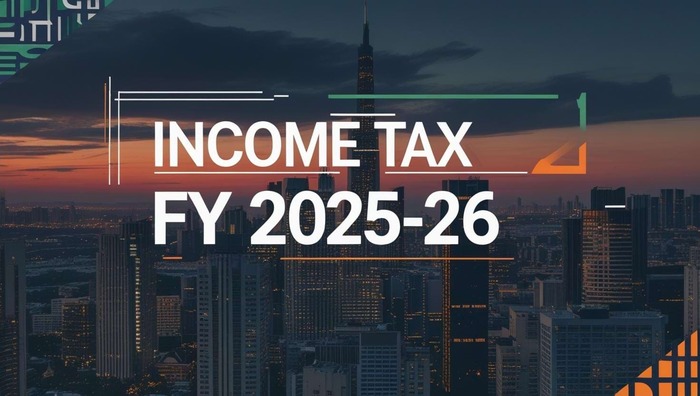Income Tax Slabs FY 2025-26 Explained: Old vs New Regime With Examples
Confused about which tax regime to choose in FY 2025-26? Learn the difference between old and new income tax regimes.
Ayushi
8/2/2025


Choosing the right tax regime can make a huge difference in the income tax paid every year. With two alternatives in hand — the new regime and the old regime — most taxpayers in India are confused as to which one is most suitable for them in the year 2025-26.
This blog will simplify the two regimes for you, guide you through the income tax slabs of FY 2025-26, and give you simple examples so that you can make an informed choice.
🧾 What are Tax Regimes?
Simply put, a tax regime is a framework or structure through which you are taxed for your income. Currently in India, individual taxpayers have two choices:
Old Regime of taxation, permitting differing deductions and exemptions
The New Tax Regime, with lower rates but loss of all except a handful of deductions
Both are acceptable and legal. The government gives you the privilege to choose whichever is more suitable according to your financial status.
👥 Who Needs to Know This?
If you receive any income and pay taxes — whether you are a salaried individual, freelancer, professional, small business owner, or senior citizen — this blog is for you. If you are aware of your tax liability and the regime you must opt for, you can save considerable money every year.
📊 Income Tax Slabs under the New Regime (FY 2025-26)
The new system of taxation was introduced in order to ease taxing. It provides lower rates of tax at different levels of income but eliminates most tax allowances provided under the previous system.
Here is a step-by-step analysis of how tax is computed under this arrangement:
If your income is within ₹3 lakh, you pay nothing.
₹3 lakh to ₹6 lakh: 5% tax
₹6 lakh to ₹9 lakh: 10%
₹9 lakh to ₹12 lakh: 15%
₹12 lakh to ₹15 lakh: 20%
More than ₹15 lakh: taxed at 30%
Good news: There’s a rebate for incomes up to ₹7 lakh, so if you earn no more than that, your total tax will be zero even under this new regime.
A standard deduction of ₹50,000 is also permitted in the new regime, making it slightly better than before.
🏛️ Income Tax Slabs in the Previous Tax System
The older regime follows a traditional tax structure with higher tax rates. But it gives you the benefit of claiming deductions under various sections like 80C, 80D, HRA, LTA, etc.
In this system:
Up to ₹2.5 lakh: tax-free
₹2.5 lakh to ₹5 lakh: taxed at 5%
₹5 lakh to ₹10 lakh: taxed at 20%
Above ₹10 lakh: taxed at 30%
For senior citizens (age 60–80), the basic exemption limit is ₹3 lakh. For super senior citizens (above 80), it is ₹5 lakh.
🔍 Key Differences Between the Two Regimes
The primary distinction between the old and new taxation systems is the incentives provided by them.
Old Regime:
Allows several deductions and exemptions to reduce tax liability
Common ones: investments in LIC, ELSS, PPF, medical insurance, HRA, home loan interest
New Regime:
Leaves out the majority of deductions
Offers lower tax rates directly
Intended to be less complicated and easier to file
Important note: The new regime now includes a minimum deduction of ₹50,000, and also provides a full rebate on tax if your income is up to ₹7 lakh.
💼 Example 1: Investor Salaried Employee
Assume your annual income is ₹10 lakh. You claim:
₹1.5 lakh under Section 80C
₹25,000 under Section 80D (health insurance)
₹1 lakh as HRA
₹50,000 as standard deduction
Under Old Regime:
These deductions reduce your taxable income and lighten your tax burden considerably.
Under New Regime:
You forgo all these deductions except ₹50,000 (standard). The rest of your income is taxed across various slabs, from 5% to 30%.
Result: The old regime saves you more tax.
👔 Example 2: Salaried Employee Without Deductions
Now imagine you earn ₹7 lakh per year but don’t claim any deductions. You don’t invest, pay insurance, or rent.
Under Old Regime:
Only the basic exemption applies, and you still have to pay some tax.
Under New Regime:
You get a ₹50,000 standard deduction. Since your income is below ₹7 lakh, you qualify for a full tax rebate under Section 87A.
Result: The new regime works better — you pay zero tax.
💡 So, What Tax Regime Should You Choose?
It all depends on your earnings and the deductions you're eligible for.
Choose the Old Regime if:
You invest in PPF, ELSS, NPS, or life insurance
You pay health insurance premiums
You receive HRA and pay rent
You have a home loan
You claim multiple deductions
If your total deductions are ₹3 lakh or more, the old regime is more tax-efficient.
Choose the New Regime if:
You don’t claim many deductions
You are a young earner with fewer responsibilities
You prefer a simpler, quicker process
Your income is under ₹7 lakh (full rebate)
This regime suits freelancers, gig workers, and salaried individuals without tax-saving habits.
🔁 Can You Switch Between the Two Regimes?
Yes — if you are a salaried employee, you can change your regime every year while filing ITR.
If you earn business income, switching from old to new is allowed only once. Reverting back isn’t permitted easily.
👵 What About the Elderly?
Senior citizens benefit more from the old regime due to higher exemption limits.
If you're 60+ and have deductions like 80C and 80D, the old regime could be more beneficial.
However, if your income is below ₹7 lakh and you don’t claim deductions, the new regime still gives you a full rebate — making it the better option.
⚠️ Common Mistakes to Avoid
Many people choose the new regime just because it seems simpler. But that can be a costly mistake if you’re eligible for multiple deductions.
Here’s what to avoid:
Not comparing your tax under both regimes
Forgetting to claim deductions in the old regime
Assuming the new regime is better for everyone
Missing out on the Section 87A rebate under the new regime
Always do a yearly comparison before you file your return.
✅ Final Thoughts
The decision between the old and new tax regimes is not permanent — it’s something you can reassess every year.
If you’re someone who invests for tax savings, the old regime is likely the best choice. But if you want a cleaner and easier filing experience, and don’t claim deductions, the new regime could be your go-to.
A small comparison before filing your ITR can result in thousands — sometimes lakhs — of savings.
🔍 Related Questions (FAQs)
Which tax regime is better for salaried employees in FY 2025-26?
If you claim deductions like 80C and HRA, the old regime may benefit you. Otherwise, the new regime could be better.
Can I change my tax regime after filing ITR?
No. Once your ITR is submitted and verified, you cannot change the regime.
Are deductions like 80C available in the new regime?
No, except for a few like NPS employer contribution. Most deductions are not allowed.
Who should choose the new regime?
Low-income earners, freelancers, and those not claiming deductions.
About Company


